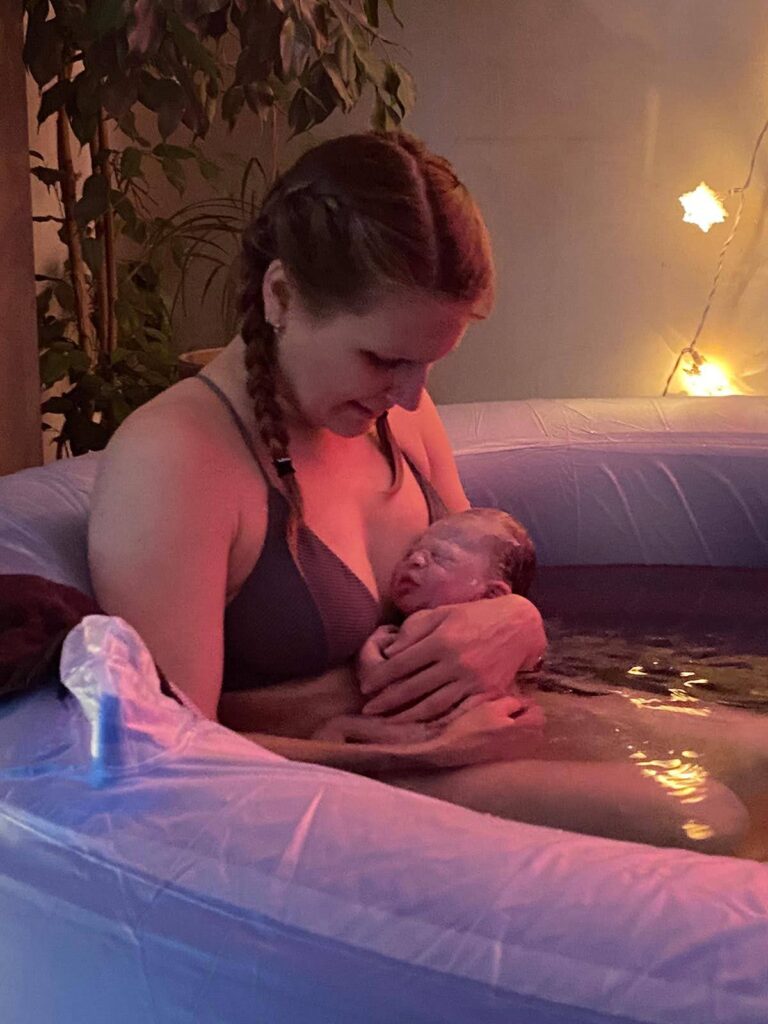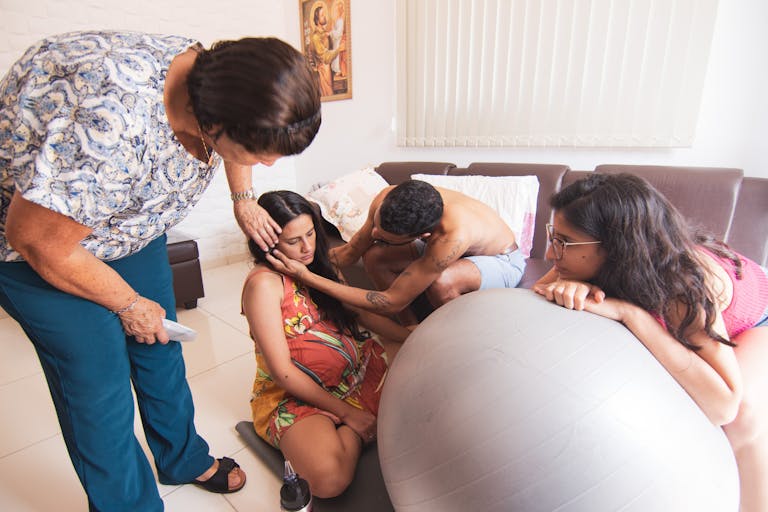Essential Guide To Waterbirth
Water birth was first reported in medical journals as early as 1805, but has been more popular for birthing people since 1980-90s to aid a more natural and comfortable birth. There is a wealth of research to support the safety of birthing in water, as well as the benefits of feeling less pain, reducing the need for synthetic oxytocin use and medical pain relief. Anecdotally, most women really enjoy labouring in water, and some believe it offers babies a smoother transition Earthside. As a midwife, I see people instantly relax as they enter the pool, the warmth surrounds them and the water makes them feel more buoyant.
Birth pool room on the Lotus suite at LGI
Where can I have a water birth in Leeds?
Across Leeds, there are 5 birth pools available for use: 2 on delivery suite at St James’ Hospital, 1 on delivery suite at Leeds General Infirmary and 2 on the Lotus Suite, a midwifery-led birth centre, co-located with the delivery suite at LGI. You can also have a water birth if you are planning a home birth in Leeds (see below). You don’t need to (and can’t) ‘book’ a water birth: if it’s something you know you definitely want, mention it when you arrive or call the hospital to let them know you’re in labour. It is rare that all of them are in use but occasionally this happens!!
Can I have a water birth if my labour is induced?
There is no hard and fast answer to this. If you’ve been on one of my courses, you’ll know that there is also no ‘can’ and ‘can’t’ in maternity care, but that it can often feel like you need permission to do a lot of things. NICE guidance states that midwives and care providers should ‘offer the opportunity to labour in water for pain relief’ and whilst it would be easy for me to just say yes you can have a water birth with an induced labour, it would be irresponsible as it does not prepare you for the resistance that you might meet if planning this. Some hospitals do not have (or have very few) waterproof, wireless CTG machines, which would mean having to choose between continuous CTG monitoring and birthing in water. With the use of synthetic oxytocin during labour, a continuous CTG is highly recommended vs intermittent auscultation due to the medicalised nature of the labour. You can find more information on when continuous monitoring during labour might be useful here, although it is important to remember to ask about the reasons and evidence behind why it is being recommended for you as some may be more significant than others.
There may also be a concern around the use of a cannula (IV drip) in your hand and the pool, however, most trusts have no clear guidance on this and you could ensure you keep the hand out of the water, use a waterproof dressing or even cover with a glove to reduce chance of infection.
In many trusts, if you are having an induction for ‘post-dates’ (somewhere before 42 weeks) and no prostaglandins are used, you may fall into the criteria of being ‘low-risk’ and therefore intermittent auscultation can be used to monitor your baby during labour, which can be done easily when labouring in water.
If you have some prostaglandins for cervical ripening or are being induced for a medical reason, but labour from artificial membrane rupture (ARM) and don’t require synthetic oxytocin, you may still be recommended a CTG which could be a barrier to water birth in some trusts. It is important here to explore your options and reasons for recommendations with your care providers in this instance.
Can I have a water birth if my pregnancy is high risk (gestational diabetes, previous C-section etc)?
Again, this is very similar to the above answer but you may have less resistance if you are in spontaneous labour than if you are induced. If you are happy with the recommendation for continuous CTG monitoring and your trust offers waterproof machines – go for it!
It is useful if you have a personalised care plan written prior to labour so you don’t have to have these discussions with multiple members of staff when you attend hospital in labour.
How do I have a water birth at home in Leeds?
Having a homebirth is one way to boost your chances of a water birth, mostly because you don’t have to worry about them being available because nobody is going to come and get in yours, but also because evidence shows that labouring at home decreases the chance of medical intervention – aka. exiting said pool and often getting onto a bed. Birth pools are not provided by the home birth team but there are a few options for sourcing your own:
- Leeds/Wakefield pool hire scheme: £10 hire charge and £50 returnable deposit – https://www.yorkshireoaksdoula.co.uk/birth-pool-hire-scheme
- Birth Pool in a Box: you can buy a birth pool or liner/any accessories needed with a 10% discount from myself – https://birthpoolinabox.refr.cc/default/u/leah01?s=esp&t=cp
- Leeds Homebirth Support Group on Facebook: others may be selling their pools or unused equipment that you can collect from around Leeds – https://www.facebook.com/groups/LeedsHomebirth/
You can find out more about home birth in Leeds in this blog post.

What pain relief can I have with a water birth?
There are plenty of pain relief options that can be used alongside birthing in water. These include:
- Oral analgesia: paracetamol & dihydrocodeine
- Entonox (gas and air)
- Massage
- Guided breathing and relaxation
- Birth comb
- Sometimes morphine (depending on Trust local guidance – you may be asked to get out of the pool for a short while and see how you feel once you’ve had morphine as it can make you drowsy which increases risk of collapse whilst in the pool)
We must also remember that water immersion itself offers great relief and research shows those who use water during labour request much less medical pain relief.
More information about pain relief options in labour can be found here: https://www.labourpains.org/during-labour/pain-relief-and-anaesthesia-choices-during-labour
Can I have active management of the third stage in a water birth?
Yes, although you would usually be asked to leave the pool once your baby has been born for the third stage if you wanted active management as this includes cutting and clamping the cord (can still have this delayed if you wish) and a midwife using gentle traction to help deliver the placenta. To do this safely, the birthing person would need to be in a semi-recumbent position so the uterus can be palpated and guarded properly.
Will I have a perineal tear during a water birth?
Whilst it was originally thought that birthing in water would increase your chance of a severe perineal tear due to the lack of hands-on protection from midwives; however, a magnitude of research now proves to us the opposite – water birth can be protective against perineal tearing.
A large Cochrane review including 15 independent studies concluded that birthing in water has no effect on the chance of severe perineal tear (known as OASIs, 3rd or 4th degree tears or those affecting the anal sphincter). Additional research from Burns et al., 2022 showed an increased chance of an intact perineum (no tears whatsoever) for those birthing in water.
What we aren’t 100% sure of are the reasons behind these apparent benefits: it could be that the warm water helps to stretch the muscles of the perineum making them less susceptible to damage, or that upright birth positions are more common in water, or that it tends to be those in spontaneous labour in the pool.
It’s clear that the research isn’t conclusive and that more variables need to be taken into account when studying this topic, however, it is evident that water birth does not have a significantly negative effect on the rate of perineal tearing.



